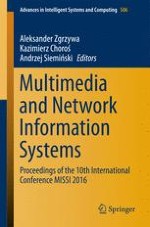Recent years have seen remarkable progress on both advanced multimedia data processing and intelligent network information systems. The objective of this book is to contribute to the development of multimedia processing and the intelligent information systems and to provide the researches with the essentials of current knowledge, experience and know-how. Although many aspects of such systems have already been under investigation, but there are many new that wait to be discovered and defined.The book contains a selection of 36 papers based on original research presented during the 10th International Conference on Multimedia & Network Information Systems (MISSI 2016) held on 14–16 September 2016 in Wrocław, Poland. The papers provide an overview the achievements of researches from several countries in three continents.The volume is divided into five parts: (a) Images and Videos - Virtual and Augmented Reality, (b) Voice Interactions in Multimedia Systems, (c) Tools and Applications, (d) Natural Language in Information Systems, and (e) Internet and Network Technologies.The book is an excellent resource for researchers, those working in multimedia, Internet, and Natural Language technologies, as well as for students interested in computer science and other related fields.
